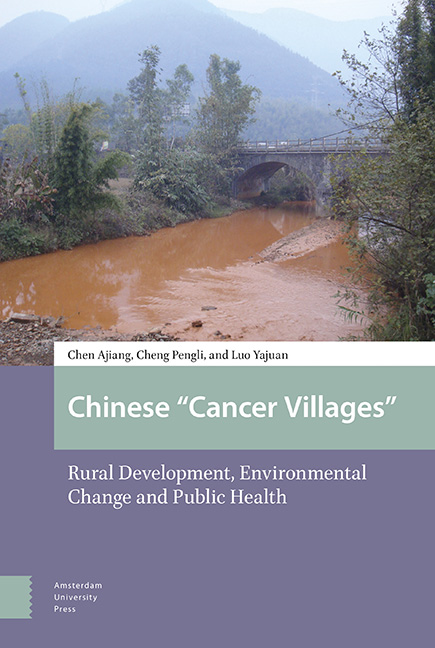Book contents
- Frontmatter
- Contents
- List of Figures, Graphs and Tables
- Acknowledgements
- Preface to the English Language Edition
- 1 Retrospective Thoughts on the ‘Cancer Village’ Phenomenon
- 2 The Ins and Outs of a ‘Cancer Village’
- 3 A Subei ‘Cancer Village’
- 4 Environmental Change and Health Risks
- 5 A Prosperous ‘Cancer Village’
- 6 Coexistence of Poverty and Cancer
- 7 Problematization and De-stigmatization
- 8 Behind the ‘High Incidence of Lung Cancer’
- 9 Villagers’ Perceptions of and Responses to the Relationship between Cancer and Pollution
- 10 Villagers Strategies for Mitigating Environmental Health Risks
- Index
- Index (Chinese) 中文索引
5 - A Prosperous ‘Cancer Village’
Published online by Cambridge University Press: 20 November 2020
- Frontmatter
- Contents
- List of Figures, Graphs and Tables
- Acknowledgements
- Preface to the English Language Edition
- 1 Retrospective Thoughts on the ‘Cancer Village’ Phenomenon
- 2 The Ins and Outs of a ‘Cancer Village’
- 3 A Subei ‘Cancer Village’
- 4 Environmental Change and Health Risks
- 5 A Prosperous ‘Cancer Village’
- 6 Coexistence of Poverty and Cancer
- 7 Problematization and De-stigmatization
- 8 Behind the ‘High Incidence of Lung Cancer’
- 9 Villagers’ Perceptions of and Responses to the Relationship between Cancer and Pollution
- 10 Villagers Strategies for Mitigating Environmental Health Risks
- Index
- Index (Chinese) 中文索引
Summary
Abstract Money, or life? Town and Village Enterprises helped local farmers get rich quickly, but they also caused serious environmental pollution that was a threat to people's health. Through a study of a village in northern Zhejiang, this chapter shows how, through their daily experiences, villagers established a logical relationship between industrial pollution and cancer and came to believe that the incidence of cancer was not only high, but strongly related to pollution. Facing health risks from pollution, the villagers initially engaged in resistance, but when this strategy was unsuccessful, they later switched to less active measures.
Keywords: Jiangnan, rural industrial pollution, risk perception, environmental resistance, village doctors
Lake Tai is situated in the Yangtze River Delta, a region with some of the strongest potential for development in China. Over the last 30 years, economic reform and modernization have put the region at the forefront of the whole country. Its impressive growth has stimulated the development of eastern China and the Yangtze River basin and contributed to the economic and cultural development of the country. A special feature of the region's economic development has been Town and Village Enterprises (TVEs), especially in the Southern Jiangsu (Sunan) and Northern Zhejiang (Zhebei) regions around Lake Tai. These have greatly increased the income and standard of living of rural residents; compared to rural parts of other regions in China, the area around Lake Tai has become prosperous, and its farmers rich.
Industrial development in villages and towns surrounding Lake Tai made farmers wealthy, but it also polluted the water and caused environmental degradation. In the 30 years after reform and opening up, industrial enterprises in the Lake Tai countryside grew in both size and number, and pollution emissions increased as a result. Due to the widespread coverage in the media, public attention to water pollution in Lake Tai has focused on the annual outbreaks of green-blue algae each summer, but in fact, water pollution in the region in recent years has had two characteristics. First, it is worse downstream from Lake Tai than in the lake itself, but because Lake Tai is the source of drinking water for the surrounding cities, more attention has been paid to controlling pollution in the lake.
- Type
- Chapter
- Information
- 'Chinese Cancer Villages'Rural Development, Environmental Change and Public Health, pp. 159 - 186Publisher: Amsterdam University PressPrint publication year: 2020

